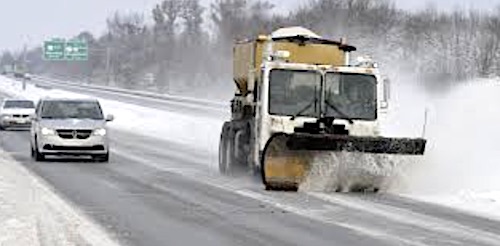Winter is here. KYTC snowfighters ready to kick ice!
22,893 tons of salt stockpiled in District 12’s seven counties
Pikeville, Kentucky (November 30, 2020) – Tomorrow morning we might wake up to snow-covered roads. We will try to decide if we can get off the hill and out to the main road. We wonder if there is ice underneath the snow. Then we hear the snowplow scraping and crunching, clearing a path. The snowplow team from the Kentucky Transportation Cabinet is already on the job. We whisper “thank you,” and prepare for the day.
The skill and concentration of Highway District 12’s team of snowplow operators make them a force to match the winter weather. “Our men and women have spent months getting ready for winter,” said Mary Westfall-Holbrook, D12 chief district engineer. “The salt domes are full; liquid calcium chloride tanks are topped off; the men have made thousands of gallons of brine.”
Last month and earlier this month, a few maintenance facilities were shut down due to COVID-19. At this time, all crews are working and no facilities are closed. “We are certainly mindful of mask-wearing and sanitation measures at all times,” Westfall-Holbrook said. “There is no more important preparation for serving the public at this time than the health and safety of our employees. We have a few across our seven counties who are in quarantine as a precaution, but those who tested positive over the past few months, thankfully, have recovered.”
A, B, C PRIORITY SYSTEM: Highway District 12 covers 2,145 miles of roadway. Roadway miles are different than lane miles. Counting four-lane roads and three-lane sections, D12 snowfighters are responsible for more than 4,550 lane miles of pavement.
Westfall-Holbrook explained that the Kentucky Transportation Cabinet has a system that dictates the order in which roads are cleared during a winter storm. “Roads are designated A, B, or C according to traffic counts, how many homes and businesses are served by each highway. We also take into account the main routes that first responders need to access other roads when emergencies happen, people need to get to a hospital, there is a fire, or some other life-threatening situation.
Snow and Ice Priority Maps are available by county on the Transportation Cabinet’s website: https://transportation.ky.gov/sites/snowky . Click on the box “Snow Priority Routes”. Some roads are split; in other words, part of the road may be an A route and other parts a B route.
MATERIALS INVENTORY: Terry Cole Tackett is responsible for the district’s snow and ice materials inventory. Storage domes currently hold 22,893 tons of rock salt in the 10 maintenance facilities positioned throughout District 12’s seven counties: Lawrence, Johnson, Martin, Floyd, Knott, Pike, and Letcher. Calcium chloride tanks are brimming with 93,140 gallons of the liquid snow-fighting chemical. More than 57,671 gallons of brine wait to be used in advance of a storm to prevent ice from bonding with the pavement. For hard to reach, stubborn spots, the garages have 1,220 bags of calcium chloride pellets on hand.
MAINTENANCE READINESS: Materials to spread on the roads are just the beginning of winter preparedness. District 12 uses 89 trucks with plows owned by the district, plus 15 contract trucks available on call. Each of the district’s snowplows goes through rigorous maintenance and calibration. “This equipment takes a beating,” said Darold Slone, the district’s snow and ice coordinator. “Think about it: we run these machines in the worst conditions around the clock, changing operators every 12-16 hours. The drivers get a minimum eight-hour break between shifts. The snowplows do not. We have to make sure each one is in the best possible condition before the first snowflake falls.”
Each snowplow has two drivers, one for each shift. These two men are responsible to make thorough checks of their equipment before each shift, a process which takes about 45 minutes. Their backup is the district’s Equipment Garage crew, a group of certified mechanics, welders, and heavy equipment technicians supervised by Scotty Tackett (no relation to Terry). Headquartered in Pikeville, the crew has mechanics in each county, ready to tackle all but the most serious issues. The Pikeville equipment garage keeps an inventory of parts and tools for 700 pieces of equipment and, like the materials that are spread on the pavement, this inventory is replenished well in advance of the first snowstorm.
COMMUNICATIONS: District 12 partners with the National Weather Service office in Jackson. The Jackson meteorologists focus specifically on weather events in Eastern Kentucky, using satellite, radar data, and weather spotter reports to make decisions on watches, warnings, and advisories. The Jackson office sets up regular conference call briefings which help us better prepare for the type of storm headed our way. Our 24-hour emergency operations center at the District 12 headquarters in Pikeville is in constant contact with the superintendents at each maintenance facility and the equipment garage. When the first crew is called out, the equipment garage staff is also called out. Every crew is put on alert and called out to mobilize before the storm hits that county. Our dispatchers relay information directly to each snowplow operator. The snow and ice command center at the district office keeps the Transportation Operations Center in Frankfort advised of road conditions throughout the district.
The district’s public information officer, Sara George, is also called out. “Sara notifies the public, contacts the media, calls radio and television reporters, posts on Facebook,” Slone said. “She gathers information from our command center, from the weather service in Jackson, from TOC in Frankfort, and from the maintenance superintendents and provides updates to the public so people can make wise decisions about when it is safe to be on the roadways.”
George pointed out that there are nearly 200 people at Highway District 12 who work snow and ice events. “Everyone has a specific responsibility,” she said. “It is remarkable how well everyone works together. The determination, dedication, experience, and skills of our people are outstanding. They truly care about doing a good job. When drivers partner with us, drive safely, and make sure their vehicle is winter ready, we can all get where we need to go safely, without wrecks or injuries. After all, that is the ultimate goal: to travel safely, to take care of each other on the roadways, and to survive winter storms with zero wrecks, injuries, or fatalities.”
PARTNERS IN SAFETY: If you must get out on the roads during a snow event, there are things you can do to help yourself and the snowfighters:
- Check your vehicle before you get on the road, especially your tire pressure and battery. Low or uneven tire pressure can cause a blowout. Clean any corrosion from battery posts and cable connections; wash all surfaces with battery terminal cleaner or a solution of baking soda and water. Have battery checked by a professional to ensure it is strong enough to face cold weather.
- Clean your lights, front and back. Walk around and make sure all the lights are working. Check your windshield washer fluid. Make sure your windshield wipers work properly. Check your tire pressure; it affects your traction on icy, slick pavement. Slow down. You cannot drive in a safe manner wet or icy pavement at the same speed you use on dry pavement.
- Buckle up and make sure anyone with you does the same. Make sure children are in proper child safety seats.
- Make sure you have plenty of gas.
- Stay alert. Your main responsibility is to keep your eyes on the road. Get rid of any distractions. Put away your cell phone; using it while driving is dangerous. Do not fiddle with the heater or the radio. Fix those things before you start. Don’t try to hold a cup or something to eat while driving. Keep both hands on the steering wheel.
- Do not pass a snowplow. Give them room to work. Stay a few car lengths behind the plow; it’s the safest place you can be.
- On a four- or six-lane road, if all lanes are snow-covered, drive slowly in the inside lane (the lane next to the median). Snow is plowed from left to right, from the passing lane toward the shoulder.
- Treat a non-working traffic signal as a four-way stop.
- Drive as though your life depends on it – because it does.













![Foothills-Bundle] Foothills-Bundle](https://thelevisalazer.com/wp-content/uploads/2020/05/Foothills-Bundle-422x74.jpg)






